


In the 21st Century we are bombarded with advertising, be it on the radio, television, the internet or through magazines, newspapers, outside adverts on hoardings and on vehicles. Most of these methods rely on the fact that nearly all of us are literate; in fact in 2018 that meant about 99% of the population in the UK.
However, the situation back in the mid 18th century was completely different. In 1801 the population of Exeter was 20,000. About that time literacy amongst the male population was less than 60% and less than 40% for females. Newspapers were emerging locally towards the end of the 18th Century, Trewmans Exeter Flying Post being the oldest. To those without reading skills ‘advertising’ was very much by word of mouth and recommendation. Those living in small towns and villages in the 18th and 19th century may well have been served by pedlars or hawkers or mongers. For country dwellers venturing into the city was a very rare occasion, often restricted to market day. Planning was essential and it would be necessary to be armed with a long mental list of Things to Do and What to Buy and Where to Go to ensure the journey was worthwhile.
I have selected a series of Adverts from local papers to show how they have developed over the decades, how they gradually progressed from a very ‘wordy’ format with little variation of typeface and font size to punchy Box Adverts and even a few that were able to show illustrations.
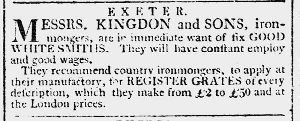 Samuel Kingdon senior ran his business from 1768 until his death in 1797 when his wife Jane assumed control. She in turn passed control (see first notice) to her sons Samuel & William as ‘Kingdon & Sons’. This Advert dated July 1806 combines a Situations Vacant ad with a promotion on the supply of Register Grates.
Samuel Kingdon senior ran his business from 1768 until his death in 1797 when his wife Jane assumed control. She in turn passed control (see first notice) to her sons Samuel & William as ‘Kingdon & Sons’. This Advert dated July 1806 combines a Situations Vacant ad with a promotion on the supply of Register Grates.
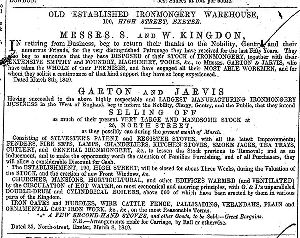 This next advert is from the 10th March 1849 and was inserted in the Western Times. This relates to the time that the brothers Samuel and William Kingdon were retiring and Garton & Jarvis were taking over the business. It describes items that are available for sale (but carefully avoids any mention of Price!). Earlier Garton & Jarvis adverts do exist from before the merger but they are effectively on a different path, whereas our historic pathway traces through Kingdons, Portburys, Southcombe and ultimately back to John Atken.
This next advert is from the 10th March 1849 and was inserted in the Western Times. This relates to the time that the brothers Samuel and William Kingdon were retiring and Garton & Jarvis were taking over the business. It describes items that are available for sale (but carefully avoids any mention of Price!). Earlier Garton & Jarvis adverts do exist from before the merger but they are effectively on a different path, whereas our historic pathway traces through Kingdons, Portburys, Southcombe and ultimately back to John Atken.
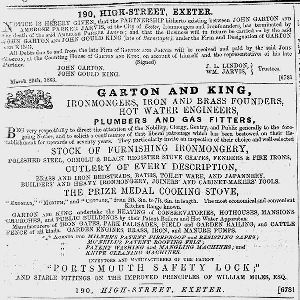 In 1863 the Company changed its name on the death of Ambrose Parker Jarvis, his place in the Company being taken by John Gould King from Barnstaple. In the North Devon Journal on the 14th May 1861 appeared this combination of Notice and Product Promotion, but as was commonplace at the time details of cost were not included. This advert is typical of the period, a mass of text and very little illustration. Throughout the whole 8 pages of the 31st July issue of the Exeter Flying Post appeared only a small image of a sailing ship, a horse, a head and shoulder image of a gentleman and the Royal Coat of Arms. There was, however, a lot to read!
In 1863 the Company changed its name on the death of Ambrose Parker Jarvis, his place in the Company being taken by John Gould King from Barnstaple. In the North Devon Journal on the 14th May 1861 appeared this combination of Notice and Product Promotion, but as was commonplace at the time details of cost were not included. This advert is typical of the period, a mass of text and very little illustration. Throughout the whole 8 pages of the 31st July issue of the Exeter Flying Post appeared only a small image of a sailing ship, a horse, a head and shoulder image of a gentleman and the Royal Coat of Arms. There was, however, a lot to read!
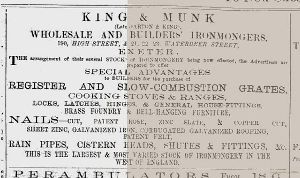 Another, but brief, change in the business came about with the merging with Munk around 1883 to become King & Munk (see the King & Munk page). One should point out that many newspapers in the early days, perhaps even up to the 1950s, did not print on pristine snow white paper, the images have been converted to this format to make them easier to view. Here is a Half Altered and Half Original version. This advert was aimed at the Building Trade and is from the Plymouth & Exeter Gazette dated 17th April 1883.
Another, but brief, change in the business came about with the merging with Munk around 1883 to become King & Munk (see the King & Munk page). One should point out that many newspapers in the early days, perhaps even up to the 1950s, did not print on pristine snow white paper, the images have been converted to this format to make them easier to view. Here is a Half Altered and Half Original version. This advert was aimed at the Building Trade and is from the Plymouth & Exeter Gazette dated 17th April 1883.
By 1887 normal service has been resumed with the Company having dissolved the partnership with Munk and reverted back to Garton & King. A pointed printed comment in the Express & Echo Advert of the 14th April 1887 (below left) shows and reminds the reader that the firm’s name came into being in 1863 on the death of William Parker Jarvis and the new partner, John Gould King joining the company and renaming the company Garton & King. The extensive and varied amount of Garden Apparatus and Stock is impressive – if only one could go back in time to view what was on offer.
By the time of this triple advert, 24th August 1869, (above right) which was placed in the Exeter & Plymouth Gazette, the style of advert has changed and the typefaces are more varied and utilise large fonts. The adverts less cluttered, the cost of items, however, is obviously a taboo subject - ‘Estimates on application’. Nearly all the newspaper advertisements shown so far were aimed at the well-healed and well-to-do. These three adverts are particularly aimed at Landowners and the gentry though mention is made of the less expensive Kitchen Ranges such as the Little Gem and the Cottage Stove. Not many of your average working folk could boast Vineries or Conservatories but certain businesses involved in transportation and agriculture might well have been attracted to the Stable Fixtures and Fittings.
The 1851 Great Exhibition caused the Company to make placements in the local press but they took more the form of Notifications and Information about the products on show, Well beyond the end of the Exhibition adverts continued to emphasise the interest Prince Albert had shown and his satisfaction with the Company’s Cottage Stove which he had bought and had installed in his Model Cottage (see the Great Exhibition page).
We now enter the era of the Single Column adverts. The first selection of four date from 1892 and were placed, as with the examples above, in local newspapers. In the main advertising was predominately connected with the Ironmongery Shop but the first two promote the Foundry side of the business. The first advert emphasizes the ability of the firm to supply all the necessary ironwork for buildings and structures. A service they had been providing certainly in the 1830s as the building of the West of England Fire & Life offices readily confirms (see A Two-Way Traffic). If you have explored elsewhere on the site you will realise that the Foundry was but a stone’s throw away across the street from the back entrance of the High Street shop which also backed onto Waterbeer Street.
Each one of this group appeared in a single column width, excepting the advert for Lawn Mowers, dated 1898 and the Express & Echo ad for Hot Water Circulation. These generally covered the width of two standard columns.
Sales of the popular Haldon Range continued into the 20th Century, prices on application!
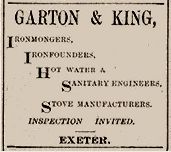 January 1902 |
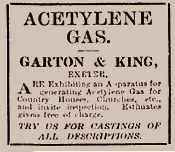 November 1902 |
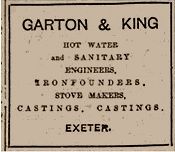 January 1904 |
||
 September 1905 |
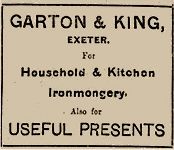 December 1905 |
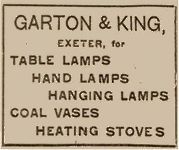 September 1908 |
Similarly this next group of six appeared.
 January 1902 |
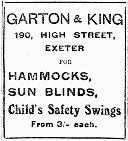 November 1902 |
 August 1904 |
||
 September 1905 |
 December 1906 |
 September 1908 |
The last batch of six covers the period 1909 to 1916.
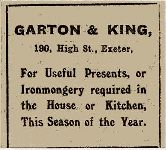 January 1909 |
 June 1910 |
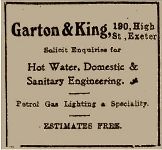 January 1910 |
||
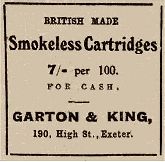 January 1912 |
 February 1914 |
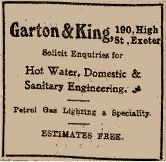 January 1916 |
The final advert (right) which promoted the range of Ironmongery, with a suggestion as to the usefulness of items from the Kitchen or House Departments as presents was placed in the Exeter & Plymouth Gazette in December 1917. Although the Company were on the Telephone by 1902 on Exeter 104, this number did not appear on any of the Company’s adverts. After 1917 the practice of placing adverts by the Company in the local press seems to have died out.
The only frequent adverts that did appear that included the Company Name were for the Beeston Boiler Company. The Adverts (below right) appeared roughly bi-monthly between May 1930 and February 1938.
After a break of some fifteen years the Company recommenced advertising by placing a prominent banner position advert in the Western Morning News on the 28th December 1932. The advert was frequently posted in this position up until May 1933.
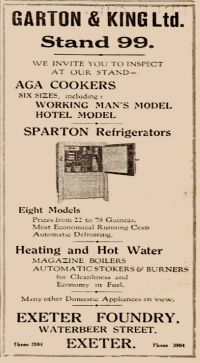 This is not to say the Company between the early 1800s and the latter part of the 20th century did not place adverts in Directories, Trade Journals, periodicals and Trade papers – they did. This page deals with local Newspaper Adverts placed by the Company mainly up until the closure of the Ironmongers Shop at 190 High Street in 1933.
This is not to say the Company between the early 1800s and the latter part of the 20th century did not place adverts in Directories, Trade Journals, periodicals and Trade papers – they did. This page deals with local Newspaper Adverts placed by the Company mainly up until the closure of the Ironmongers Shop at 190 High Street in 1933.
I have, however included the advert on the right which relates to the Company Stand at the 1936 Devon County Show.
My main source of illustrations for this page has been from local sources and the British Newspaper Archive. The latter is not all embracing and there doubtless are advertisements from before 1849 which I have not been able to source.
Since the closure of the Ironmongers shop which was brought about mainly by the retirement of Hugo Holladay, it has often been the Showroom, firstly at Central Station and from 1958 onwards located at 19 North Street that has been responsible for placing adverts in the local papers. In the main, as previously stated, these usually promoted AGAs, Bendix and Miele products. The AGA made an appearance just as the Ironmongers shop was about to close in 1933 as can be seen in the image on the AGA page (AGA, A Grand Affair), but the event was not publicised at that time as far as I can discover.
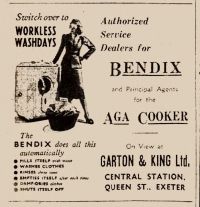 The next advert actually mentions not only AGA but also Bendix brand products and dates from December 1948. The Central Station Showroom is under the Management of Alec Holladay and the premises will continue to be the Showroom for the Company until the lease runs out in 1957. The Miele company that I mentioned previously, entered the UK Market in 1963 and there has been a long association between G & K and Garton King Appliances with Miele products. Miele produced the first dishwasher in Europe in 1929 and, apart from deviating in WW2 into producing control units for torpedoes for the Kriegsmarine, produced the first fully automatic washing machine in 1956.
The next advert actually mentions not only AGA but also Bendix brand products and dates from December 1948. The Central Station Showroom is under the Management of Alec Holladay and the premises will continue to be the Showroom for the Company until the lease runs out in 1957. The Miele company that I mentioned previously, entered the UK Market in 1963 and there has been a long association between G & K and Garton King Appliances with Miele products. Miele produced the first dishwasher in Europe in 1929 and, apart from deviating in WW2 into producing control units for torpedoes for the Kriegsmarine, produced the first fully automatic washing machine in 1956.
My Aunt, Alec Holladay’s wife, entered a Miele Competition with the suggested slogan “Don’t buy her a Mink, buy her a Miele!” The prize was a BMC Mini!
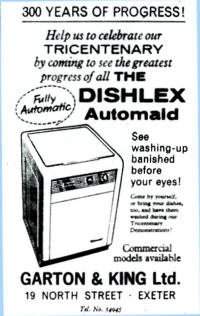
This recently discovered advertisement was published in the Express & Echo, and possibly also in the Western Morning News, sometime during 1961, the Tricentenary Year of the Company; the same year that the original Golden Hammer publication was produced and circulated. There is a saying that you should refrain from ‘washing your dirty linen in public’ – whether this saying extends to having your ‘dirty dishes washed in public’ is not clear, though the Advert innocently invites the public to turn up with their dirty dishes to have them washed during the Tricentenary Demonstration! Quite how many took advantage of this unusual offer will probably never be known - not many, I imagine.
For decades the Company advertised in the Devon & Exeter Gazette. In 1898 the Gazette introduced a Picture Puzzle Competition whereby readers could submit by post to the Offices of the Newspaper (229 High Street, Exeter) their Cut-out Entry Form identifying the answer to the Weekly Picture Puzzle. Entries were to be sent by Penny Post (those were the days!).
The prizes were 3/6d (18p), 2/6d (13p), and three silver Pencil Cases. The Figures in brackets are the decimal equivalent rounded up as the Half Decimal Pence was withdrawn in 1984.
The fiendishly cunning plan behind the Competition was to persuade readers to pay more attention to the advertisements printed in the paper, and Garton & King’s advert featured in the competition in 1902, 1903 & 1910. The 1910 Competition involved the advertisement by G & K for the Petrol Gas Lighting that the company were appointed agents for - details of the advert and the System of Petrol Gas Lighting are at the bottom of the Mixed Bag page. The Gazette posted each week’s Competition on the Friday, and on the following Tuesday the Winners’ names were published. I wonder if someone still has a Silver Pencil Case passed down through the generations? The Competition ran until late 1914, the prizes being offered were similar to 1898!

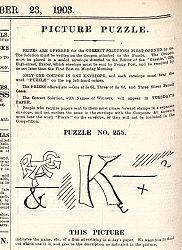
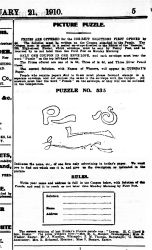
Three Devon & Exeter Gazette puzzles (from 1902, 1903 and 1910) - the solution to each was "Garton and King".
Below, the announcement of the winners of Puzzle 535 (1910)

March 2022
Top of the page
See also:
Golden Hammer Chapters 3, 4 and 5
King & Munk — Great Exhibition — Flying the Flag
Waterbeer Street — High Street — AGA
Sitemap / Contents